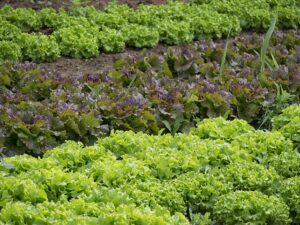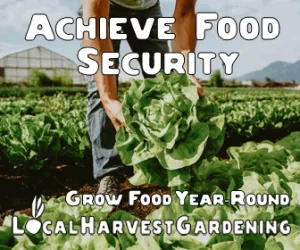Zone 8’s mild temperatures allow for year-round gardening. Zone 8 growing allows you to grow a mix of perennials, annuals, and vegetables for a robust, flourishing garden.
Understanding Zone 8 Growing
- In the spectrum of USDA hardiness zones, Zone 8 stands out for its relatively mild winters and extended growing seasons. This zone encompasses regions where the average annual minimum winter temperature falls between 10 to 20 degrees Fahrenheit, making it an ideal environment for a wide range of plants. Its inhabitants, both novice and seasoned gardeners, can cultivate a diverse selection of both warm and cool weather crops. This expansive growing season provides ample opportunity for experimentation and learning in the garden.
- The typical climate in Zone 8 is characterized by its moderate conditions. Summers are generally warm with peak temperatures rarely becoming excessively hot, allowing for the growth of heat-loving plants. Winters, on the other hand, are quite mild with infrequent frost, permitting a variety of cold-hardy plants to thrive. Rainfall distribution is usually even throughout the year, providing a consistent water supply for plant growth. The relatively stable weather conditions in Zone 8 make it a conducive environment for year-round gardening.
Types of Plants Suitable for Zone 8 Growing
- Annuals and perennials both have a place in Zone 8 gardens. Annual plants, such as marigolds, cosmos, and zinnias, grow, bloom, and die in a single growing season. They are perfect for adding a burst of color to your garden during the summer months. Perennials, on the other hand, are plants that live for more than two years. They bloom over the spring and summer, die back every autumn and winter, and then return in the spring from their rootstock. Examples of perennials suited to Zone 8 include echinacea, hostas, and daylilies. These plants offer consistency and can form the backbone of your garden design. By incorporating both annuals and perennials, you can create a garden that has interest and color throughout the entire growing season.
- Vegetables are another fertile category for Zone 8 gardening. Many vegetables thrive in this zone’s moderate conditions. Cool season vegetables like lettuce, broccoli, and peas can be planted early in the spring and again in fall for a bountiful harvest. Warm season vegetables such as tomatoes, peppers, and cucumbers relish the balmy summer conditions. With thoughtful planning and timely planting, it’s possible to enjoy a fresh and varied vegetable harvest across the seasons in Zone 8.
Can you grow potatoes in zone 8?
Yes, you can grow potatoes in Zone 8. However, it is important to choose the right variety for this climate. Some potato varieties that are well-suited for Zone 8 include Kennebec, Yukon Gold, and Red Pontiac. These varieties can tolerate the mild winters and hot summers of this zone and produce a good yield. It is best to plant potatoes in early spring, about 3-4 weeks before the last frost date, and harvest them in mid to late summer. Proper soil preparation, regular watering, and fertilization are key to growing healthy and flavorful potatoes in Zone 8. So if you love potatoes and live in Zone 8, don’t hesitate to give them a try!
Can you grow wheat in zone 8?
While wheat is not traditionally grown in Zone 8, it is possible to grow it in this zone with some adjustments. Wheat is a cool season crop and requires cooler temperatures for optimal growth. In Zone 8, it can be grown as a winter crop when the weather is milder and cooler. It is important to choose varieties that are suited for warmer climates and have a shorter growing season. Wheat can also be grown as a cover crop in Zone 8, providing benefits to the soil and other plants in the garden. With proper care and attention, it is possible to successfully grow wheat in Zone 8 and expand your gardening options even further. So go ahead and experiment with this versatile grain in your Zone 8 garden!
What are some tips for growing wheat in zone 8?
To successfully grow wheat in Zone 8, there are a few helpful tips to keep in mind:
- Choose the right variety: Look for varieties that are suited for warmer climates and have a shorter growing season.
- Plant at the right time: Wheat is a cool-season crop and should be planted in the fall for a spring harvest or in early spring for a summer harvest.
- Prepare the soil: Wheat prefers well-draining, loamy soil with a slightly acidic pH level. Work in compost or other organic matter to improve the soil’s texture and fertility.
- Provide adequate water: While wheat is relatively drought-tolerant, it still requires consistent moisture to produce a successful crop. Water deeply and regularly, especially during the early stages of growth.
- Keep an eye out for pests: Common wheat pests in Zone 8 include aphids, armyworms, and Hessian flies. Regularly monitor your plants and take action if you notice any signs of infestation.
- Harvest at the right time: Depending on the variety, wheat can take anywhere from 90 to 120 days to mature. Harvest when the grains are fully formed and dry.
By following these tips, you can successfully grow wheat in Zone 8 and enjoy a bountiful harvest of this nutritious and versatile grain. However, don’t be afraid to also try out different substitute grains for a diverse and exciting garden. Who knows, you may just discover a new favorite that thrives in your Zone 8 climate! Experiment with other grains like quinoa, amaranth, or buckwheat and see which one grows best for you. Not only will this add variety to your diet, but it can also help promote sustainability by reducing our reliance on monoculture
What’s a good substitute grain for wheat that grows well in zone 8?
One possible substitute grain for wheat that grows well in Zone 8 is sorghum. This drought-tolerant crop can be grown as a summer crop in this zone and has a similar nutritional profile to wheat. It also has a shorter growing season, making it well-suited for the milder winters of Zone 8. Other potential substitutes include millet, quinoa, and amaranth, which are all versatile and nutritious grains that can thrive in warm temperatures. By experimenting with different substitute grains, you can diversify your garden and cultivate a variety of crops in Zone 8 for a well-rounded harvest. So why not try growing some of these alternative grains and see which one works best for you? You may just discover a new favorite for your Zone 8 garden.
- Fruits also flourish in Zone 8, with a wide array of options for the home gardener. From citrus trees like oranges, lemons, and grapefruits, to deciduous fruits such as apples, peaches, and plums, the choice is rich and varied. Berries, including raspberries, blackberries, and strawberries, are also well-suited for this zone, providing a bountiful harvest in the summer months. Furthermore, more exotic fruits like figs and pomegranates can also be successfully grown in this zone, given the right care and attention. A well-planned fruit garden in Zone 8 can provide fresh, nutritious fruit for most of the year, adding a delightful variety to your home produce.
Can you grow citrus in Zone 8?
Yes, citrus trees can be grown in Zone 8 with proper care. While they may not tolerate frost and freezing temperatures well, there are several varieties of cold-hardy citrus that can thrive in this zone. These include Satsuma mandarins, Meyer lemons, and calamondin oranges. With some extra protection during colder months and a sunny location, you can enjoy the fresh, juicy fruits from your very own citrus trees in Zone 8. It is important to research and choose varieties that are suitable for your specific area within Zone 8, as microclimates can vary greatly. Some areas may have slightly warmer or cooler temperatures, which can affect the success of certain fruit trees. Overall, with proper planning and care, growing citrus is possible in zone 8.
Can you grow apples in zone 8?
Yes, apples can also be successfully grown in Zone 8. While they are traditionally associated with cooler climates, there are several varieties that have been developed specifically for warmer zones, including Gala, Golden Delicious, and Fuji apples. These varieties require fewer chill hours and can tolerate higher temperatures than traditional apple trees. However, it is important to note that even these adapted varieties may still struggle in extreme heat and may benefit from some shade during the hottest parts of summer. With proper care and attention, apples can thrive in Zone 8 and provide a bountiful harvest of fresh, crisp fruit for your enjoyment. As with all fruit trees, it is important to choose varieties that are suitable for your specific area within Zone 8 and to provide adequate care
- Trees and shrubs form the architectural framework of any garden, and in Zone 8, there’s an impressive variety to choose from. Evergreen trees and shrubs, like hollies and cypresses, provide year-round structure and color, while deciduous trees, such as oaks and maples, offer spectacular fall foliage. Smaller flowering shrubs like azaleas and rhododendrons can provide bursts of color in the spring and early summer. When choosing trees and shrubs for a Zone 8 garden, it’s important to consider their mature size and their light and water requirements. With careful selection and proper placement, trees and shrubs can bring an added layer of beauty and complexity to your Zone 8 garden landscape.
Tips and Techniques for Gardening in Zone 8
- Proper soil preparation is crucial for a successful garden in Zone 8. Start by testing your soil’s pH levels and nutrient content, which can guide necessary amendments. Many plants thrive in well-drained soil with a neutral to slightly acidic pH. Enrich your garden soil with organic matter like compost or well-rotted manure, which will improve soil fertility and structure. For clayey soils, consider adding grit or sand to enhance drainage. Conversely, for sandy soils, incorporate organic matter to increase water retention capacity. Always remember, a well-prepared soil is the foundation of a lush and productive garden.
- Watering is another essential aspect of maintaining a garden in Zone 8. The watering regime depends on the types of plants you have and the prevailing weather conditions. Most plants prefer deep, infrequent watering, which encourages them to develop deep root systems, making them more drought-resistant. Water your garden in the early morning or late evening when temperatures are cooler to minimize evaporation. In the heat of summer, your garden may require watering twice a week, while in the cooler months, once a week or less frequently may suffice. Always check the soil moisture levels before watering; the soil should be dry to the touch at a depth of about an inch. Overwatering can lead to root rot and other fungal diseases. Installing a drip irrigation system can ensure consistent, efficient watering, while also saving water.
- Adequate sunlight is vital for your plants’ healthy growth in Zone 8. Most vegetable and flowering plants require full sun, which means at least six hours of direct sunlight each day. However, some plants such as ferns, hostas, and certain types of hydrangeas, fare better in partial shade or full shade. Hence, it is crucial to understand the specific light requirements of your plants. Plant placement plays a significant role in ensuring they receive the right amount of sunlight. Keep sun-loving plants in the sunniest parts of your garden and shade-loving plants in areas with more shade. Remember, even plants that require full sun appreciate some protection from the intense afternoon sun during hot summer days. You might need to create some shade using garden structures or other plants to ensure your garden thrives.
- Pest and disease management is a critical part of maintaining a healthy garden in Zone 8. A variety of pests, such as aphids, beetles, and slugs, and diseases like powdery mildew and blight can afflict your plants. Regularly inspect your plants for signs of pests and disease. If you notice curled leaves, spots, unusual discoloration, or visible pests, appropriate action should be taken immediately to mitigate the issue. Organic methods of pest control, such as introducing beneficial insects, using homemade sprays, or installing physical barriers, are typically safer for the environment and beneficial garden creatures. Disease can be prevented by ensuring good airflow around your plants, watering at the base instead of overhead, and practicing crop rotation. If disease does strike, removing and disposing of affected plant parts can help prevent the spread. Remember, a proactive approach to pest and disease management can save you a lot of time and effort in the long run.
Seasonal Guide for Gardening in Zone 8
- Spring: This season is the time for planting most of your annuals, perennials, and vegetables. Spring in Zone 8 starts earlier than in many other zones, so you can begin planting as early as February or March. Start by preparing your garden beds by removing any weeds and amending the soil with compost
- Summer: With the heat of summer, watering becomes essential. Make sure to deep water your plants regularly, particularly during dry spells. This is also an ideal time to plant heat-tolerant crops like okra, sweet potatoes, and peppers. Regularly check your garden for pests and diseases and manage them promptly.
- Fall: This is the perfect time to plant trees, shrubs, and perennials, as the cooler weather helps them establish roots without the stress of summer heat. Fall is also when you should harvest summer crops and plant cool-season veggies like lettuce, kale, and spinach. Be sure to clean up fallen leaves and other garden debris to prevent overwintering pests and diseases.
- Winter: While gardening activity slows down during winter, it’s an optimal time to plan for the next year. Order seeds and bulbs for spring, prune dormant trees and shrubs, and add mulch to your garden beds to protect them from potential freezes. Remember to provide extra water for your plants if winter rainfall is insufficient.
Troubleshooting Common Zone 8 Growing Issues
- Dealing with Heat and Drought: Zone 8 can experience intense summer heat and periods of drought. Plant species adapted to arid conditions, such as succulents or native grasses, can thrive under these conditions. For more sensitive plants, consider installing drip irrigation or using mulch to retain soil moisture. Monitor plants carefully for signs of heat stress, such as wilting or scorched leaves.
- Managing Pests and Diseases: Every garden is susceptible to pests and diseases, but regular inspections can help identify potential problems before they become serious. Use integrated pest management strategies, including beneficial insects and organic sprays, to manage pests. Remove and dispose of any diseased plant material to prevent the spread of fungal or bacterial infections.
- Overcoming Poor Soil Conditions: If your soil is heavy clay, sandy, or depleted of nutrients, amendments can improve its texture and fertility. Add organic matter like compost or well-rotted manure to enhance soil structure, retain moisture, and supply nutrients. Regular soil testing can guide your fertilization strategy to address specific nutrient deficiencies.
- Handling Unusual Weather Events: Unpredictable weather, such as late frosts or sudden downpours, can challenge even the most experienced gardener. Protective structures like greenhouses or cold frames can shield plants from adverse weather. Diversifying your plant selections can also help ensure that some plants thrive, regardless of the weather.
Resources for Zone 8 Gardeners
- Recommended Books and Online Resources:
- “The New Organic Grower, 3rd Edition” by Eliot Coleman: This comprehensive guide covers everything from soil management to pest control, with a focus on organic techniques.
- “Gardening in the South” by Mark Weathington: A great resource for understanding the unique challenges of southern gardening.
- The Old Farmer’s Almanac website: Provides long-range weather forecasts and timely tips for gardeners.
- The USDA’s Plant Hardiness Zone Map website: Offers detailed information about the different plant hardiness zones.
Local Gardening Clubs and Societies:
- The Southern Garden History Society: Offers educational resources and organizes events for gardeners in the South.
- Your local Master Gardener program: Provides training and volunteer opportunities for gardening enthusiasts.
Zone 8 Plant Nurseries and Suppliers:
- Plant Delights Nursery: Specializes in unique and hardy plants for Zone 8.
- The Tree Center: Offers a wide variety of trees and shrubs suitable for Zone 8. Check their website for more details.
- Your local county extension service: May have lists of local nurseries and suppliers.



